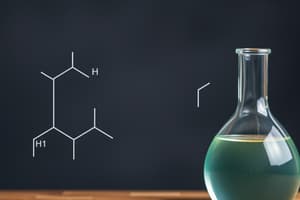Podcast
Questions and Answers
What does the law of multiple proportions state?
What does the law of multiple proportions state?
- The properties of the compounds formed are always different compared to the individual elements.
- The total mass of reactants is equal to the total mass of products in a reaction.
- Two elements can combine to form only one unique compound.
- Different masses of one element combine with a fixed mass of another in whole number ratios. (correct)
In the reaction CH₄ + 2O₂ → CO₂ + 2H₂O, what is the mass of CO₂ produced when 3 moles of CH₄ react with 2 moles of O₂?
In the reaction CH₄ + 2O₂ → CO₂ + 2H₂O, what is the mass of CO₂ produced when 3 moles of CH₄ react with 2 moles of O₂?
- 44 g (correct)
- 22 g
- 88 g
- 32 g
Which of the following is the limiting reagent when 3 moles of CH₄ react with 2 moles of O₂?
Which of the following is the limiting reagent when 3 moles of CH₄ react with 2 moles of O₂?
- O₂
- H₂O
- CH₄ (correct)
- CO₂
What is the value of Avogadro's number?
What is the value of Avogadro's number?
If the molar mass of water is 18 g/mol, how many moles are present in 180 g of water?
If the molar mass of water is 18 g/mol, how many moles are present in 180 g of water?
Who proposed the law of conservation of mass?
Who proposed the law of conservation of mass?
In the reaction C + O₂ → CO₂, if the reactants' total mass is 44 g, what must be true according to the conservation of mass?
In the reaction C + O₂ → CO₂, if the reactants' total mass is 44 g, what must be true according to the conservation of mass?
What is the definition of molarity?
What is the definition of molarity?
What is the empirical formula of an oxide of iron that contains 69.9% iron and 30.1% oxygen?
What is the empirical formula of an oxide of iron that contains 69.9% iron and 30.1% oxygen?
Flashcards are hidden until you start studying
Study Notes
Law of Multiple Proportions
- If two elements form multiple compounds, the mass ratios of one element, when combined with a fixed mass of the other, are in small whole number ratios.
- Example: Hydrogen and oxygen can form water (H₂O) and hydrogen peroxide (H₂O₂).
- In these compounds, the masses of oxygen that combine with 2g of hydrogen are 16g (water) and 32g (hydrogen peroxide), resulting in a ratio of 1:2.
Limiting Reagent and Calculation of CO₂
- In the reaction between methane (CH₄) and oxygen (O₂), 2 mol of O₂ react with 1 mol of CH₄ to produce CO₂ and H₂O.
- Starting with 3 mol of CH₄ and 2 mol of O₂, only 1 mol of CH₄ can react due to the limited O₂ amount, resulting in the production of 1 mol of CO₂.
- The mass of CO₂ produced can be calculated as 1 mol × 44 g/mol = 44 g.
- CH₄ is identified as the limiting reagent since it is fully consumed during the reaction.
Avogadro's Number
- Avogadro's number is 6.022 x 10²³, representing the number of molecules in one mole of a substance.
Moles of Water
- In 180 g of water (H₂O), the number of moles can be calculated using the formula: moles = mass (g) / molar mass (g/mol).
- For water, this results in 180 g / 18 g/mol = 10 mol of water.
Molarity
- Molarity is defined as the number of moles of solute per liter of solution, representing concentration.
Law of Conservation of Mass
- This law, proposed by Antoine Lavoisier, states that mass is neither created nor destroyed during a chemical reaction.
- Example chemical reaction: C(s) + O₂(g) → CO₂(g)
- Calculation: The total mass of reactants (12g C + 32g O₂) equals the total mass of products (44g CO₂), illustrating the conservation of mass principle.
Studying That Suits You
Use AI to generate personalized quizzes and flashcards to suit your learning preferences.




